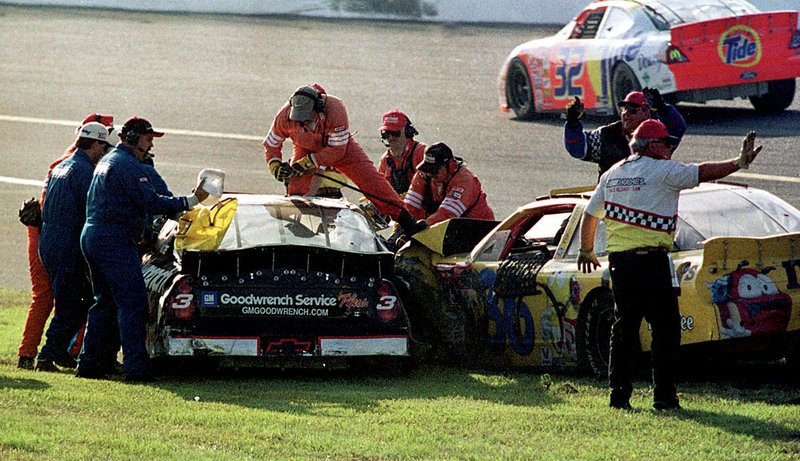ORLANDO, Fla. — Seventeen minutes.
The clock starts ticking when three emergency medical technicians pull up to the No. 3 Chevrolet Monte Carlo that’s wrecked at Daytona International Speedway.
Tick-tick: Driver Tommy Propst pulls up, expecting to find Dale Earnhardt - his former schoolmate in Mrs. Lefler’s first-grade class at Royal Oaks Elementary School in Kannapolis, N.C. - cussing and cranky because he’s just crashed on the last lap of the 2001 Daytona 500.
Tick-tick: Jason Brown smells the fumes of the transmission oil and the scent of the rubber tires, and feels the heat from the car. He sees fans start trickling up, next to a fence, and everything going eerily quiet.
Tick-tick: Patti Dobler reaches in from the passenger door, and she knows. They look at each other and continue to work on Earnhardt, who is pulseless and nonresponsive. This is not good, Dobler thinks to herself.
The extrication team is there now, cutting into the top of the car to pull Earnhardt out of there as delicately as possible, to avoid any damage to the spine, in case he is alive.
“Get your head down, Patti!” someone screams.
She is in the car. She knows for sure now. She pulls off his right black glove and sticks it in a right pocket of his fire suit. Holding Earnhardt’s headin her hands, she closes his eyes and then puts her head down. She says a prayer.
“To me, he wasn’t Dale Earnhardt,” she says today. “He was somebody’s father. He was somebody’s husband.”
The ambulance comes and takes Earnhardt to Halifax Medical Center.
Seventeen minutes have passed.
The three EMTs who were the first responders to the scene remember much of the details vividly. How could they not? It shook them to the core. Brown had to park at a neighbor’s house to avoid the media. Dobler changed her phone number. Brown did, too. Propst went to work atan Orange County firehouse one day to find a Good Morning America crew waiting for him. The crew had arrived at 4 a.m.
Everybody wanted to know. What did you see? What happened? Was the seat belt cut?
“Boy, what a mess,” Propst recalls.
A decade has passed, and they finally can talk about it now. Perhaps it will offer some closure. Perhaps it never will.
“I am constantly reminded of it every day, whether I want to or not,” Dobler said. “If you could just take the No. 3 off the numbers table and have Dale Junior stop doing commercials and not advertise for NASCAR anymore, it all wouldn’t comeback to me.”
Dobler and Brown managed to slide out of the public limelight after NASCAR’s investigation into the crash. It included a re-enactment of the response team’s actions, and what everybody saw and did during those frantic minutes. Dobler and Brown remain convinced that the seat belt was frayed and did not hold up, as a NASCAR investigation concluded..
Propst, to this day, remembers the seat belt as being intact. He said as much 10 years ago in an interview with The Orlando Sentinel. Propst, a certified EMT and firefighter for 24 years at the time, came forward because Bill Simpson, the seat-belt manufacturer, was getting vilified. Strangely enough, no one from NASCAR had bothered calling Simpson to get a statement.
He has not been back to a NASCAR event since then.
The EMTs respectfully disagree on the seat-belt issue. They have lost touch over the years but are still fond of each other.
They forever will be intertwined in one of the darkest moments in sports history.
Dobler, now 48, has moved to Keystone Heights, Fla., to get away from the city hubbub.
Propst, 59, retired Sept. 29, 2007, after 31 years.
Brown, 43, is still with the Orange County Fire Department as a paramedic, but he has not worked a race at Daytona for years.
All of them have no connection with the Speedway these days.
Dobler quit last year and never has looked back.
After she left, she went into a beat-up trailer for a garage sale. She peeked into a room to see if there were any items that would catch her attention, when she saw an odd sight: The room had a hospital-sized twin bed, a candle burning by it, and it was filled with Dale Earnhardt memorabilia.
She wondered about the back story, but ended up just walking away and leaving.
She got into her truck and saw her old Speedway credential. What the hey; she had no use for it anyway. She went back and hung it on the door.
After she left, a truck came rambling down behind her on the dirt road, motioning her to pull over. A woman came out of the truck and was crying.
“You know my 84-year-old father lives in that room, and he knows you,” the woman said. “He knows everything there is to know about Dale Earnhardt.
“And that candle in his room, he lit the night of his death and that candle has never gone out. There’s been different candles, but he just transfers the flame from one to the other. But that candle has been burning 10 years. You don’t know how much that meant to my dad.”
There is one tangible reminder of that day that Dobler has kept in the closet all these years.
She doesn’t really know what to do with the bloodstained blue fire suit. She brings herself to drag it out of the closet. She doesn’t want to sell it because she fears repercussions from NASCAR and elsewhere.
Patti had brought her daughter Jackie, then 11, to her first NASCAR race that day.
After the accident, Jackie saw her mom getting out of a truck by the infield care center, wearing that blood-stained fire suit.
“Mommy, mommy!” she screamed, thinking Patti had been hurt.
Her daughter has never been back to a NASCAR race since that day.
Sports, Pages 26 on 02/20/2011

